Simon de Monfort, 6th Earl of Leicester, 1st Earl of Chester (May 23, 1208 - August 4, 1265), sometimes
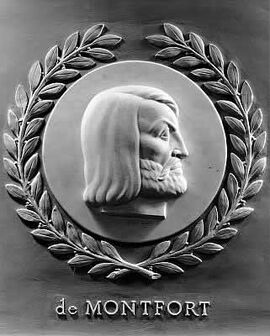
Relief of Simon de Montfort in the Chamber of the United States House of Representatives
referred to as Simon V de Montfort to distinguish him from other people called Simon de Monfort, was a French-English nobleman. He led the barons' rebellion against King Henry III of England during the Second Barons' War of 1263-4, and subsequently became de facto ruler of England. During his rule, de Monfort called the first directly elected parliament in medieval Europe. For this reason, de Monfort is regarded today as one of the progenitors of modern parliamentary democracy. After a rule of just over a year, de Monfort was killed by forces loyal to the king in the Battle of Evesham.
Family and Early Life
De Monfort was the youngest son of Simon de Montfort, a French nobleman and crusader, and Alix de Montmorency. His paternal grandmother was Amicia de Beaumont, the senior co-heiress to the Earldom of Leicester and a large estate owned by her father Robert de Beaumont, 3rd Earl of Leicester in England, but King John of England would not allow a French subject to
| Simon de Montfort, 6th Earl of Leicester | |
|---|---|
|
Title Held |
1230 - 4 Aug 1265 (35 years) |
|
Predecessor |
Simon de Montfort, 5th Earl of Leicester |
|
Successor |
None, title forfeit |
|
Father |
Simon de Montfort, 5th Earl of Leicester |
|
Mother |
Alix de Montmorency |
|
Born |
23 May 1208 |
|
Died |
4 Aug 1265 (age 57) in the Battle of Evesham |
|
Burial |
Evesham Abbey |
|
Relation |
3rd cousin 27x removed and husband of 23rd Great-Grand Aunt |
take ownership of such an estate in England.
As a boy, de Monfort accompanied his parents during his father's campaigns against the Cathars. He was with his mother at the siege of Toulouse in 1218, where his father was killed after being struck on the head by a stone pitched by a mangonel. On the death of their father, de Monfort's elder brother Amaury succeeded him. Another brother, Guy, was killed at the siege of Castelnaudary in 1220. As a young man, Montfort probably took part in the Albigensian Crusades of the early 1220s.
In 1229 the two surviving brothers (Amaury and Simon) came to an arrangement whereby Simon gave up his rights in France and Amaury gave up his rights in England. Thus free from any allegiance to the King of France, de Monfort successfully petitioned for the English inheritance, which he received the next year, although he did not take full possession for several years, and was not formally recoginzed as earl.
Simon was a distant cousin of King Henry III; his ancestor Simon I de Monfort was father of Bertrade de Monfort who herself was a paternal great-grandmother of King Henry II.
Royal Marriage
In January 1238 de Monfort married Eleanor of England, daughter of King John and Isabella of Angouleme and sister of King Henry III. While his marriage took place with the king's approval, the act itself was performed secretly and without consulting the great barons, as a marriage of such importance warranted. Eleanor had previously been married to William Marshal, 2nd Earl of Pembroke, and she swore a vow of perpetual chastity upon his death, when she was sixteen, which she broke by marrying de Monfort. The Archbishop of Canterbury, Edmund Rich, condemned the marriage for this reason. The English nobles protested the marriage of the King's sister to a foreigner of modest rank; most notably, Eleanor's brother Richard, 1st Earl of Cornwall rose up in revolt when he learned of the marriage. King Henry eventually bought off Richard with 6,000 marks and peace was restored.
The marriage brought the manor of Sutton Valence in Kent into de Monfort's possession. Relations between King Henry and de Monfort were cordial at firrst. Henry lent him his support when de Monfort embarked for Rome in March 1238 to seek papal approval for his marriage. When Simon and Eleanor's first son was born in November 1238 (despite rumors, more than nine months after the wedding), he was baptized Henry in honor of his Royal uncle. In February 1239, de Monfort was finally invested with the Earldom of Leicester. He also acted as the King's counsellor and was one of the nine godfathers of Henry's eldest son, Prince Edward who would inherit the throne and become Edward I.
Crusade and Turning Against the King
Shortly after Prince Edward's birth, however, there was a falling out. Simon owed a great sum of money to
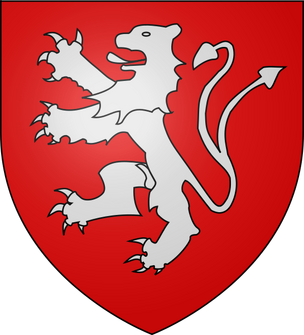
Coat of arms of Simon de Montfort
Thomas II of Savoy, uncle of Queen Eleanor, and named Henry as security for his repayment. King Henry had evidently not been told of this, and when he discovered that Monfort had used his name, he was enraged. On August 9, 1239 Henry confronted Monfort, called him a excommunicant and threatened to imprison him in the Tower of London. "You seduced my sister", King Henry said, "and when I discovered this, I gave her to you, against my will, to avoid scandal." Most historians perceive this to be the outbursts of an angry monarch, rather than fact. Simon and Eleanor fled to France to escape Henry's wrath.
Having announced his intention to go on crusade two years before, Simon raised funds and travelled to the Holy Land, but does not seem to have ever faced combat there.
That autumn, he left Syria and joined King Henry's campaign in Poitou. The campaign was a failure, and an exasperated de Monfort declared that Henry should be locked up like Charles the Simple. Like his father, Simon was a hardened and ruthless soldier, as well as a capable administrator. His dispute with King Henry came about due to the latter's determination to ignore the swelling discontent within the country, caused by a combination of factors, including famine and a sense among the English Barons that King Henry was too quick to dispense favor to his Poitevin relatives and Savoyard in-laws.
In 1248, de Monfort again took the cross, with the idea of following Louis IX of France to Egypt. But, at the repeated requests of King Henry and Council, he gave up this project in order to act as Governor in the unsettled and disaffected Duchy of Gascony. Bitter complaints were excited by the rigor with which de Monfort suppressed the excesses of the Seigneurs and of contending factions in the great communes. Henry yielded to the outcry and instituted a formal inquiry into Simon's administration. Simon was formally acquitted on the charges of oppression, but his account were disputed by Henry, and Simon retired in disgust to France in 1252. The nobles of France offered him the Regency of the kingdom, vacated by the death of Queen Blanche of Castile, but he preferred to make his peace with Henry which he did in 1253, in obedience to the exhortations of the dying Grosseteste. He helped King Henry in dealing with the disaffection in Gascony; but their reconciliation was a hollow one, and in the Parliament of 1254, Simon led the opposition in resisting a demand for a subsidy. In 1256-57, when the discontent of all classes was coming to a head, de Monfort nominally adhered to the Royal cause. He undertook, with Peter of Savoy, the Queen's uncle, the difficult task of extricating the King from the pledges which he had given to the Pope with reference to the Crown of Sicily; and Henry's writs of this date mention de Monfort in friendly terms. But at the "Mad Parliament" of Oxford (1258) de Montfort appeared side by side with the Earl of Gloucester, at the head of the opposition. It is said that de Monfort was reluctant to approve the oligarchical constitution created by the Provisions of Oxford, but his name appears in the list of the Fifteen who were to constitute the supreme board of control over the administration. There is better ground for believing that he disliked the narrow class-spirit in which the victorious Barons used their victory; and that he would gladly have made a compromise with the moderate Royalists, whose policy was guided by Prince Edward. But the King's success in dividing the Barons and in fostering a reaction, rendered such projects hopeless. In 1261, Henry revoked his assent to the Provisions, and de Monfort, in despair, left the country.
War Against the King
Simon de Monfort returned in 1263, at the invitation of the barons, who were now convinced of the king's hostility to all reform; and raised a rebellion with the avowed object of restoring the form of government which
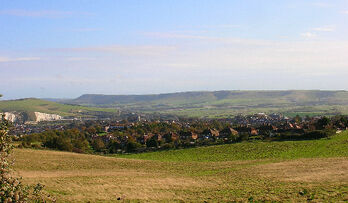
Site of the Battle of Lewes
the Provisions had ordained. For a few weeks it seemed as though the royalists were at his mercy; but he made the mistake of accepting Henry's offer to abide by the arbitration of Louis IX of France. At Amiens, in January 1264, the French king decided that the Provisions were unlawful and invalid. De Montfort, who had remained in England to prepare for the ruling, at once resumed the war, and thus exposed himself to accusations of perjury, from which he can only be defended on the hypothesis that he had been led to hope for a genuine compromise. Though merely supported by the towns and a few of the younger barons, he triumphed by superior generalship at the Battle of Lewes on May 14, 1264, where the king, Prince Edward and Richard of Cornwall fell into his hands. De Montfort used his victory to set up the government by which his reputation as a statesman stands or falls. The weak point in his scheme was the establishment of a triumvirate (consisting of himself, the young Earl of Gloucester and the Bishop of Chichester) in which his colleagues were obviously figureheads. This flaw, however, is mitigated by a scheme which he simultaneously promulgated for establishing a thorough parliamentary control over the executive, not excepting the triumvirs. The Parliament of 1265 (De Monfort's Parliament), which he summoned, was, it is true, a packed assembly; but it can hardly be supposed that the representation which he granted to the towns was intended to be a temporary expedient.
De Monfort sent out representatives to each county and to a select list of boroughs, asking each to send two representatives (this was not the first parliament in England, but what distinguished it was that de Monfort insisted the representatives be elected). It is from him that the modern idea of a democratic representative parliament derives. The list of boroughs which had the right to elect a member grew slowly over the centuries as monarchs gave out more Royal Charters. (The last charter was given to Newark in 1674.)
The right to vote in Parliamentary elections for county constituencies was uniform throughout the country, granting a vote to all those who owned the freehold of land to an annual rent of 40 shillings. In the Boroughs, the franchise varied and individual boroughs had varying arrangements.
The reaction against his government was baronial rather than popular; and the Welsh Marcher Lords particularly resented Monfort's alliance with Llywelyn ap Gruffydd, Prince of Wales. Little consideration for English interests is shown in the Treaty of Pipton which sealed that alliance on June 22, 1265.
Many other barons who had initially supported him now started to feel that Monfort's reforms were going too far, and his many enemies turned his triumph into disaster. Prince Edward escaped, and Monfort's ally, Thomas de Clare, abandoned him and took with him his garrison. Though boosted by Welsh infantry sent by Monfort's ally Llywelyn ap Gruffydd, Montfort's forces were severly depleted. Prince Edward attacked the Montfort forces at Kenilworth, capturing more of Monfort's allies. Montfort himself had crossed the Severn with his army, intending to redezvous with his son Simon. When he saw the army awaiting him at Evesham, Montfort initially thought it was led by his son. But the army belonged to Prince Edward, flying the Montfort banners he had captured at Kenilworth, and so leading Simon into a trap.
Death
Simon de Montfort died on August 4, 1265 at the battle of Evesham, and was buried at the nearby Evesham Abbey. De Montfort and his army were awaiting the army led by his second son, Simon. He saw his son's

Medieval manuscript of the Battle of Evesham and mutilation of de Monfort's body
banners flying high and began to hope, with the two armies they had a fighting chance to claim England. However, his son had been ambushed, and Prince Edward, Henry's son, led the army carrying de Montfort's stolen banners. When de Montfort realized the truth, he said "May God have mercy on our souls because our bodies are theirs." On hearing that his son Henry had been killed, he replied, "Then it is time to die." From within the church of Evesham, de Montfort and his army led a final charge to their death. After a charge uphill against superior forces, Simon's army was completely destroyed; the battle was described as the "murder of Evesham, for battle it was none". His last words were said to have been "Thank God".
Simon's body was cut up and different parts sent to the Lords who had accomplished the most. His head was sent to Wigmore Castle by Roger de Mortimer, 1st Baron Wigmore as a gift to his wife, Maud. Such remains as could be found were buried under the altar of Evesham Abbey by some clerks. It was visited as holy ground by many commoners until King Henry caught wind of it. He declared that Simon deserved no spot on holy ground and had his remains reburied under an insignificant tree. The remains of some of his soliders were found in the nearby village of Cleeve Prior after fleeing from the battle of Evesham. Matthew Paris reports that the Bishop of Lincoln, Robert Grossesteste, once said to Simon's eldest son Henry: "My beloved child, both you and your father will meet your deaths on one day, and by one kind of death, but it will be in the name of justice and truth."
Evesham Abbey and the site of de Montfort's grave were destroyed with the Dissolution of Monasteries in the sixteenth century. In 1965 a memorial stone was laid on the site of the former altar by Speaker of the House of Commons Sir Harry Hylton-Foster and Archbishop of Canterbury Michael Ramsey. The inscription reads:
Here were buried the remains of
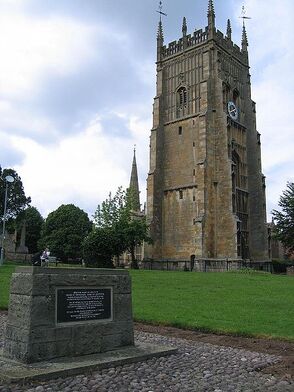
Memorial stone on the site of de Montfort's grave, Evesham
Simon de Montfort, Earl of Leicester
pioneer of representative government who was
killed in the Battle of Evesham on 4 August 1265.
This stone brought from his birthplace the
Castle of Montfort-L'Amaury in France
was erected to commemorate the seven hundredth
anniversary of his death.
Unveiled by the Speaker of the House of Commons
and dedicated by
His Grace the Archbishop of Canterbury
on the 18th day of July 1965.
Legacy
In the years that followed his death, Simon de Montfort's grave was frequently visited by pilgrims. There was an
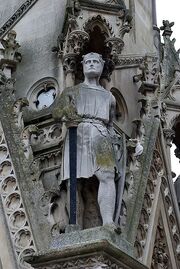
Statue of de Montfort on the Haymarket Memorial Clock Tower in Leicester
attempt to canonize him; this was not carried out however, due to opposition by the English monarchy at the time.
Today, de Montfort is mostly remembered for calling the first directly elected parliament and is regarded as one of the fathers of modern democracy. He may have a more romantic legacy; Roger Godberd, one of de Montfort's captains who survived Evesham, fought on until his capture in 1272 as a bandit or rebel in and around the Sherwood Forest area. Godberd is one candidate for being the character around whom the Robin Hood legend is based. Napoleon Bonaparte described Simon de Montfort as "one of the greatest Englishmen".
Various local honors were dedicated to his memory, and he has become eponymous several times over. De Monfort University in Leicester is named after him, as is the nearby De Montfort Hall, a concert venue. A statue of de Montfort is one of four to adorn the Haymarket Memorial Clock Tower in Leicester. A relief of de Montfort adorns the wall of the Chamber of the United States House of Representatives. De Montfort's banner described as the 'Arms of Honor of Hinckley,' shown in the stained glass image in Chartres Cathedral, is used by the town of Hinckley, part of his Earldom in Leicestershire, in their town coat of arms. It also forms part of the club crest for the town's football team Hinckley United F.C. whose stadium is named De Montfort Park. A school and a bridge on the north east stretch of the A46 are named after him in Evesham.
Family
Simon de Montfort and Eleanor of Leicester had seven children, many of whom were notable in their own right
- Henry de Montfort - (November 1238 - 1265)
- Simon the Younger de Montfort - (April 1240 - 1271)
- Amaury de Montfort, Canon of York - (1242/43 - 1300)
- Guy de Montfort, Count of Nola - (1244 - 1288) Elizabeth Woodville, Queen Consort of Edward IV of England, was one of Guy's descendants through his daughter, Anastasia de Montfort, Countess of Nola.
- Joanna de Montfort - (born and died in Bordeaux between 1248 - 1251)
- Richard de Montfort - (died 1266)
- Eleanor de Montfort - (1252 - 1282) She married Llywelyn ap Gruffydd, Prince of Wales, honoring an agreement that had been made between Earl Simon and Llywelyn. Eleanor, Lady of Wales, died on June 19, 1282 at the royal Welsh home at Abergwyngregyn, on the north coast of Gwynedd, giving birth to a daughter, Gwenllian of Wales. After Llywelyn's death on December 11, 1282, Gwenllian was captured by King Edward I and spent the rest of her life in a convent.
The last actual member of the family line to bear the name de Montfort was: Marie-Jean-Baptiste-Benoit de Monfort (1784 - 1839), 2nd Marquis of Chardonnay, Sire de La Marne, de La Malloniere, de Bicherel, who married D. Joana de Lima Barreto Coelho (London, 1814), with succession.